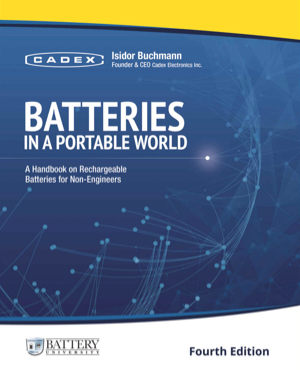The battery is increasingly promoted as a green energy solution to liberate society from the dependency of fossil fuel. While this crusade is noble and right, the battery has not yet matured to assume this vital task. Pushing the boundaries of the battery reminds us of the many limitations by being an electrochemical power source that is slow to fill, holds limited energy, runs for a time like a wind-up toy, and has a short life span of only a few hundred cycles before it becomes a nuisance.
In an age where surprise developments flash before our eyes almost daily, the battery seems slow in maturing. Improvements achieved since the commercialization of lithium-ion in 1991 by Sony pale compared to the vast advancements made in microelectronics. Compared to Moore’s Law, where the number of transistors in an integrated circuit doubles every two years, Li-ion only gained 8 percent capacity per year during the last two decades. This has slowed to 5 percent, but the good news is a cost reduction of 8 percent per year.
Progress is being made but not without roadblocks. Lithium-air, proposed in the 1970s with a theoretical specific energy resembling gasoline, has been delayed due to stability and air-purity issues as the battery “breathes” oxygen from the air. The promising lithium-metal introduced in the 1980s still grows dendrites, leading to possible violent events if an electrical short develops. Lithium sulfur may be close to commercialization, but scientists must still resolve the short cycle life. The redox-flow battery promises to be an alternative for large battery systems by pumping fluids from external tanks through a membrane that resembles a battery, but the system suffers from corrosion.
There is a glimmer of hope to increase the energy density of Li-ion by coating the anode with graphene, a layer that is only one atom thick. This is said to quadruple the energy. Emerging battery technologies take four years to commercialize, and there are no heavy lifters, or a home run.
The Joint Centre for Energy Storage Research (JCESR) is more optimistic; they gathered the brightest minds from US national laboratories, universities and private enterprises to improve the battery. With a grant of $120 million from the US Department of Energy, JCESR wants to develop a battery that is “five times more powerful and five times cheaper in five years.” They call this the 5-5-5 Plan, which should get a boost by throwing a ton of money at it.
Toyota is also in the race for a new battery, calling it the “Sakichi battery” after Sakichi Toyoda, the inventor of Japan’s power loom. (The surname Toyoda is spelled with a d.) Sakichi Toyoda is often called the father of the Japanese industrial revolution, and it is said that in 1925 he promised a yet-to-be-claimed prize of 1 million yen for a storage battery that produces more energy than gasoline. To qualify, the Sakichi battery must also be durable and quick to charge. The prize has not yet been claimed.
Consumers are generally satisfied with battery performance in portable devices, but the electric vehicle (EV) has a higher demand; cost and endurance will determine the long-term success. It’s as if the EV sets the threshold for how far the battery can go.
It makes little sense to use batteries to propel trains, ocean-going ships and large airplanes. Batteries are simply too heavy. If all engines and the fuel in an aircraft were to be replaced with batteries, the flight would last under 10 minutes before the fuel would be exhausted. Competing against fossil fuel with a net calorific value that is 100 times higher than the battery is a challenge. (See BU-1007: Net Calorific Value) Conversely, petroleum cannot match the battery, which is clean, quiet, small, and has an immediate start-up with the flick of a switch.

Comments
Looking for comments from the previous website?
Comments from the previous website are not compatible with our new commenting system but we have preserved them so our users can still reference and make use the information in them.
